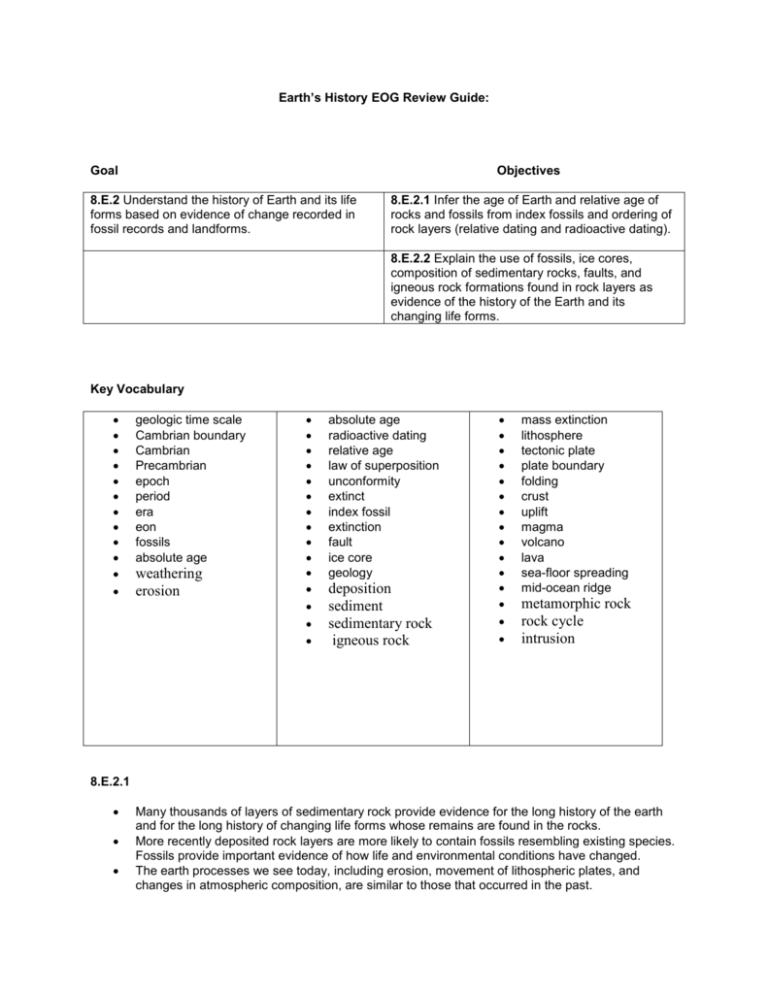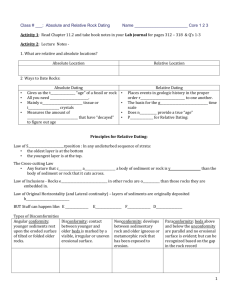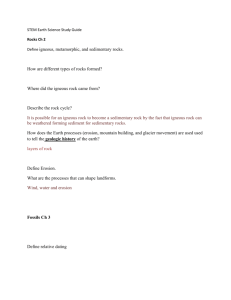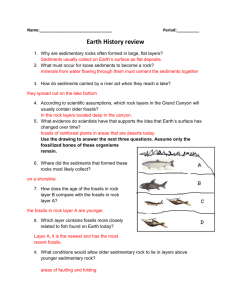EarthHistoryEOGReviewGuide
advertisement

Earth’s History EOG Review Guide: Goal Objectives 8.E.2 Understand the history of Earth and its life forms based on evidence of change recorded in fossil records and landforms. 8.E.2.1 Infer the age of Earth and relative age of rocks and fossils from index fossils and ordering of rock layers (relative dating and radioactive dating). 8.E.2.2 Explain the use of fossils, ice cores, composition of sedimentary rocks, faults, and igneous rock formations found in rock layers as evidence of the history of the Earth and its changing life forms. Key Vocabulary geologic time scale Cambrian boundary Cambrian Precambrian epoch period era eon fossils absolute age weathering erosion absolute age radioactive dating relative age law of superposition unconformity extinct index fossil extinction fault ice core geology deposition sediment sedimentary rock igneous rock mass extinction lithosphere tectonic plate plate boundary folding crust uplift magma volcano lava sea-floor spreading mid-ocean ridge metamorphic rock rock cycle intrusion 8.E.2.1 Many thousands of layers of sedimentary rock provide evidence for the long history of the earth and for the long history of changing life forms whose remains are found in the rocks. More recently deposited rock layers are more likely to contain fossils resembling existing species. Fossils provide important evidence of how life and environmental conditions have changed. The earth processes we see today, including erosion, movement of lithospheric plates, and changes in atmospheric composition, are similar to those that occurred in the past. Earth’s history is also influenced by occasional catastrophes, such as the impact of an asteroid or comet. Thousands of layers of sedimentary rock confirm the long history of the changing surface of the earth and the changing life forms whose remains are found in successive layers. The youngest layers are not always found on top, because of folding, breaking, and uplift of layers. Fossils that can be used to help determine the relative age of rock layers are called index fossils. Absolute geologic dating and relative geologic dating are two methods by which scientists try to determine the age of geologic evidence. Carbon-14 dating is an example of absolute dating, and the law of superposition is an example of relative dating. Radioactive dating is used to study the uranium in igneous and metamorphic rocks. Uranium is a mildly radioactive substance that breaks down at a slow and steady pace which cannot be altered by temperature or pressure. By looking at different rocks and comparing the amount of uranium still in the rock to the amount of lead that has been formed, scientists can measure the age of the earth. Using this method, scientists have determined that the earth is 4-5 billion years old. 8.E.2.2 Sediments of sand and smaller particles (sometimes containing the remains of organisms) are gradually buried and are cemented together by dissolved minerals to form solid rock again. Sedimentary rock buried deep enough may be re-formed by pressure and heat, perhaps melting and recrystallizing into different kinds of rock. These re-formed rock layers may be forced up again to become land surface and even mountains. Subsequently, this new rock too will erode. Rock bears evidence of the minerals, temperatures, and forces that created it. Rocks, fossils, and ice cores show: 1. Life forms have changed over time and 2. Earth’s climate and surface have changed over time. The Law of Superposition states that each undisturbed rock layer is older than the layer above it. This law is used to read rock layers. Thousands of layers of sedimentary rock confirm the long history of the changing surface of the earth and the changing life forms whose remains are found in successive layers. By studying rocks and fossils, scientists have developed a geologic time scale which outlines the major divisions of Earth’s history. Geologists have concluded that all rocks of the crust form in one of three ways: Igneous rocks are formed by the cooling and hardening of hot molten rock from inside the Earth. Sedimentary rocks are formed by the hardening and cementing of layers of sediments. The sediments may consist of rock fragments, plant and animal remains, or chemicals that form on a lake and ocean bottom. Metamorphic rocks are formed when rocks that already exist are changed by heat and pressure into new kinds of rocks. A fault is a fracture in the continuity of a rock formation caused by a shifting or dislodging of the earth’s crust, in which adjacent surfaces are displaced relative to one another and parallel to the plane of fracture. There are several types of faults.









